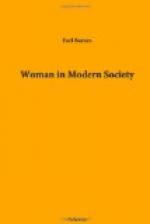And so an emancipated army of leisure has been formed which has transformed the very nature of the culture with which it has busied itself. Books, periodicals, musical instruments, travel became cheaper and cheaper as the demand increased. Wholesale production makes almost any luxury accessible to every one. It is also possible to find modern and agreeable forms for older academic exercises. If Greek and Latin were too full or too difficult, courses in Romanic and Germanic philology would do as well. Anglo-Saxon gave way to Old English; and Chaucer to the Lake Poets. Philosophy struggled for favor with the English novel on equal terms. The works of Raphael were photographed and lithographed until the Sistine Madonna became as commonly known as the face of any strenuous and popular statesman of the day. With the aid of these art productions, and John Addington Symonds, every woman with leisure became an art critic. If economics was not interesting, sociology was available; and it could be democratized to any degree desired. If travel was troublesome, one could leave it to Cook; buy a ticket and he would do the rest.
If these awakening hungers and corresponding opportunities had affected only the period of life formerly thought available for education, these changes would have come about much more slowly than they have. But the genetic conception of life, steadily popularized since 1870, has led us to see that education is coterminous with life. It seems strange that we should have ever thought that mental activity belongs alone to youth. Dorland’s study shows that in a list of four hundred fairly representative great men, only 10.25% ceased their mental activity between the ages of forty and fifty; 20.75% between fifty and sixty; 35% between sixty and seventy; 22.5% between seventy and eighty; and 6% after eighty.[28]
[28] W.A. NEWMAN DORLAND, The Age of Mental Virility. New York: The Century Company, 1908.
The recognition of such facts as these has given us a new genetic sense of life, under the influence of which mothers and grandmothers have joined the younger women in the pursuit of culture. They have formed clubs—study clubs, current events clubs, camera clubs, art clubs, literary clubs, civic clubs. They have organized courses of university extension lectures; enrolled in Chicago University correspondence courses; and have flocked to Chautauqua by the thousand in the summer, when not abroad. It is not through the generosity of men that liberal culture has come into the possession of women; they have carried it by storm and have compelled capitulation.
Judging by the facts presented in the last chapter, women are pretty fully in possession of formal education. If we examine this monopoly a little more carefully, we shall find that while in the kindergarten and in the elementary schools boys furnish 51% of the enrollment, simply because more boys are born in civilized communities than girls, as soon as we reach the high schools, girls increasingly take the lead. In 1910, the girls formed 56.45% of the enrollment in high schools—or there were 110,249 more girls than boys. The proportion of girls increased through each of the four years of the course, and of the graduates, 60.8% were girls. In the public normal schools, 64.45% of the students were girls.




